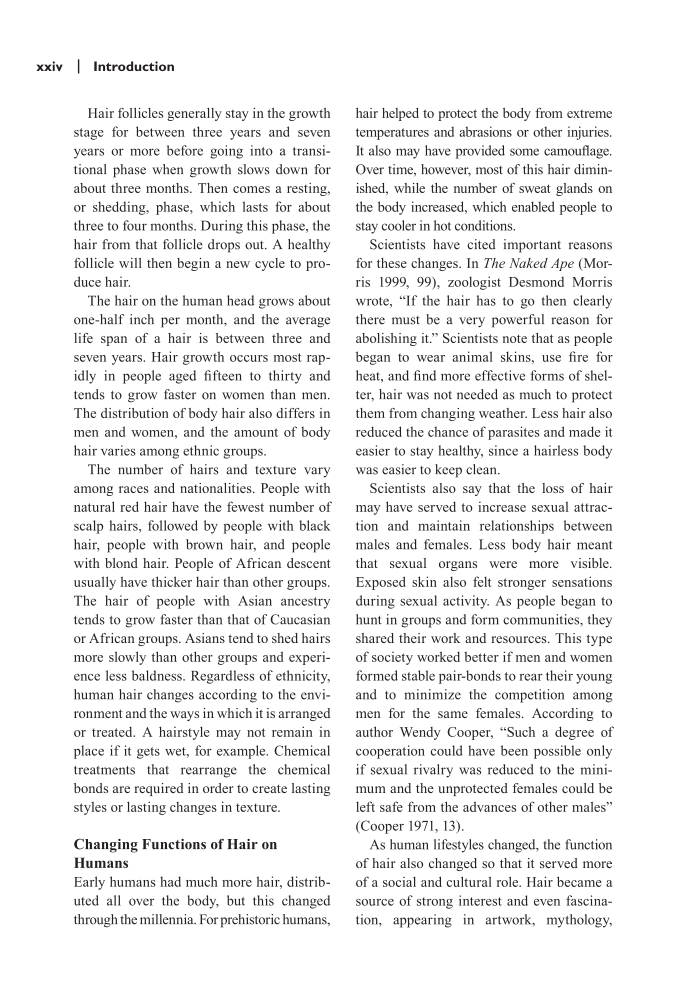xxiv |Introduction Hair follicles generally stay in the growth stage for between three years and seven years or more before going into a transi- tional phase when growth slows down for about three months. Then comes a resting, or shedding, phase, which lasts for about three to four months. During this phase, the hair from that follicle drops out. A healthy follicle will then begin a new cycle to pro- duce hair. The hair on the human head grows about one-half inch per month, and the average life span of a hair is between three and seven years. Hair growth occurs most rap- idly in people aged fifteen to thirty and tends to grow faster on women than men. The distribution of body hair also differs in men and women, and the amount of body hair varies among ethnic groups. The number of hairs and texture vary among races and nationalities. People with natural red hair have the fewest number of scalp hairs, followed by people with black hair, people with brown hair, and people with blond hair. People of African descent usually have thicker hair than other groups. The hair of people with Asian ancestry tends to grow faster than that of Caucasian or African groups. Asians tend to shed hairs more slowly than other groups and experi- ence less baldness. Regardless of ethnicity, human hair changes according to the envi- ronment and the ways in which it is arranged or treated. A hairstyle may not remain in place if it gets wet, for example. Chemical treatments that rearrange the chemical bonds are required in order to create lasting styles or lasting changes in texture. Changing Functions of Hair on Humans Early humans had much more hair, distrib- uted all over the body, but this changed through the millennia. For prehistoric humans, hair helped to protect the body from extreme temperatures and abrasions or other injuries. It also may have provided some camouflage. Over time, however, most of this hair dimin- ished, while the number of sweat glands on the body increased, which enabled people to stay cooler in hot conditions. Scientists have cited important reasons for these changes. In The Naked Ape (Mor- ris 1999, 99), zoologist Desmond Morris wrote, “If the hair has to go then clearly there must be a very powerful reason for abolishing it.” Scientists note that as people began to wear animal skins, use fire for heat, and find more effective forms of shel- ter, hair was not needed as much to protect them from changing weather. Less hair also reduced the chance of parasites and made it easier to stay healthy, since a hairless body was easier to keep clean. Scientists also say that the loss of hair may have served to increase sexual attrac- tion and maintain relationships between males and females. Less body hair meant that sexual organs were more visible. Exposed skin also felt stronger sensations during sexual activity. As people began to hunt in groups and form communities, they shared their work and resources. This type of society worked better if men and women formed stable pair-bonds to rear their young and to minimize the competition among men for the same females. According to author Wendy Cooper, “Such a degree of cooperation could have been possible only if sexual rivalry was reduced to the mini- mum and the unprotected females could be left safe from the advances of other males” (Cooper 1971, 13). As human lifestyles changed, the function of hair also changed so that it served more of a social and cultural role. Hair became a source of strong interest and even fascina- tion, appearing in artwork, mythology,
Document Details My Account Print multiple pages
Print
You have printed 0 times in the last 24 hours.
Your print count will reset on at .
You may print 0 more time(s) before then.
You may print a maximum of 0 pages at a time.


























































































































































































































































































































































































































































































































































































































































